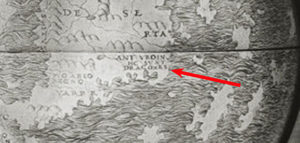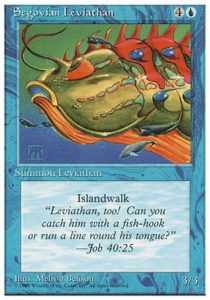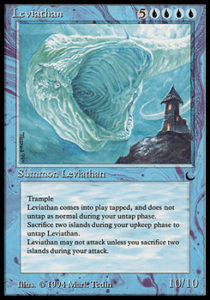This week’s Uncharted Realms is set on Theros, concurrent with the events of the Theros block. After navigating Ajani and Elspeth to the edge of Nyx, the triton planeswalker Kiora, the Crashing Wave pits an army of sea monsters against Thassa, God of the Sea. Although unsuccessful, she escapes the plane with her life and the goddess’ bident for her troubles. Her battle with Thassa is an epic confrontation of monsters of the deep, and despite Kiora’s defeat, we get to see the extent of the Blue-Green planeswalker’s power over the leviathans of the sea.
Here Be Monsters
As in the oceans of Theros, monsters haunt the historical record of the pre-modern era, lurking in every chronicle, leering down from church architecture, and rampaging across the unexplored frontiers of maps.1 Medieval peoples who held the sacred texts of Islam, Judaism, and Christianity in esteem knew that God had ordained there to be cockatrices, nephilim, and behemoths beyond the knowledge and power of mankind. Representations of these creatures have appeared throughout Magic’s history and multiverse. The Leviathan, a massive sea beast who receives extensive mention in Job and plays a role in the end of days alongside a great serpent/a dragon/Satan, gets the most explicit mention in Magic’s Legends expansion with his proper citation intact on the card Segovian Leviathan.
It is easy to see how peoples of pre-modern history imagined monsters over every horizon. In addition to being used allegorically throughout religious texts and art, beasts like the krakens which answer Kiora’s summons appear from Greek antiquity onwards in connection with divine will and natural phenomena, like the spirits of shamanic practice in medieval Central Asia and Tarkir.
Monsters haunt the historical record of the pre-modern era, lurking in every chronicle, leering down from church architecture, and rampaging across the unexplored frontiers of maps.
The natural world was largely mysterious and potentially dangerous, and the tools to understand it remained rooted in tradition and spiritual belief. Until the scientific revolution of the 16th century onwards, which introduced newly-invented implements of study as well as (arguably) modern methods of rational analysis, medieval peoples were largely left with inductive modes of reason. Plants grew, the sun rose, and ships were lost at sea. Before scientific study shined light into the dark places of the Earth, every mysterious process of the natural world involved the divine, fantastic, magical, or monstrous as its source.
Perhaps no landscape held as much mystery and peril as the ocean. The sailors and priests of Greek antiquity, upon which Magic’s plane of Theros is based, related tales of dozens of monsters that populated the Aegean and Mediterranean seas. Many, like the sea serpent that devoured Lacoon in the Odyssey, were considered native to the sea and beholden to the will of Poseidon. Others, like Scylla, a hydra-like monster who haunted the Strait of Messina, were the unintentional product of divine rivalries or punishments inflicted upon the mortal world, and varied in their obedience to the will of the gods depending upon the tale. In many cases, the monsters of the sea and land were used to explain catastrophe and warn against sin.
Releasing the Kraken
The exact term kraken, however, shows up quite a bit later in Norse chronicles of the medieval period. In the late 14th century, an extensive educational chronicle called the King’s Mirror dedicates a full chapter to the varied marine life of the North Sea. The author concludes a detailed account of different whales and fish hunted by the Norwegian people with a warning about a dread monster, too large to be believed. “On those occasions when men have seen it,” the writer described, hearkening to Arixmethes from this week’s Uncharted Realms, “it has appeared more like an island than a fish.”1 This monster, called kraken in the Old Norse language, could open a mouth the size of a fjord and swallow ships and sealife whole. Happily, concluded the author, given its size and appetite, the kraken could hardly be a numerous monster, as not even the boundless oceans could provide enough food for more than a few of its species.
“On those rare occasions when men have seen [the kraken], it has appeared more like an island than a fish.”
Unlike many of the other monsters that populate the religious texts and superstitious travelogues of the medieval period, the legend of the kraken endured. Perhaps, over the years, further sightings of giant squid and octopodes supported Norse and Grecian legends of many-limbed sea monsters. Even today, marine biologists struggle to examine live, unharmed giant squid, hampered by the vast scale of their ocean home and their relative “shyness” compared to other marine wildlife.2 Carolus Linnaeus, father of modern scientific nomenclature, was convinced of the kraken’s existence long enough to label it a cephalopod in his first classification of living organisms (although future editions excluded the mythical beast).

See the Latin text at the tip of the red arrow? “Hic Sunt Dracones” – here be dragons, on the Lenox Globe. Dragons were one of the many other beasts to appear on medieval maps and globes.
Perhaps legends of the kraken endured because the sea still inspired awe and fear enough to believe it capable of sheltering the creature. It would be easy to ascribe a monster’s appetite to the sea, and sailors into the modern age had good reason to fear storms and shipwreck, kraken or no. Through the 18th and 19th century, biologists of Linnaeus’ generation posited the kraken still sank ships and devoured sailors, even as scientific study narrowed the scope of fantastic creatures in biological taxonomy.
In either case, the kraken has proven one of the most enduring legends of historical bestiaries and superstitions. It has roots in Biblical parables of the Leviathan, Greek legends of god-spawned sea monsters, and European sailors’ accounts of huge, many-limbed squid that menaced ships and sea life. Even today, as we explore the heavens and oceans that evoked awe and wonder throughout history, it is possible that we write in the margins of our maps, “here be monsters,” lurking in the hidden crevices of our world. Listening to the list of unexplained sounds from NOAA, it is easy to imagine krakens like Kiora’s thralls, just beyond the prying eyes of humanity, waiting in the unexplored depths of our seas.
1 Although the phrase “here be dragons,” not so much. Only one globe includes this phrase in Latin. Medieval cartographers occasionally depicted allegorical beasts (such as a great serpent signifying the Devil) in addition to a creative range of beasts thought to exist in foreign lands.
2 http://www.usnews.com/news/articles/2013/01/09/remarkable-new-giant-squid-footage-surprises-experts



